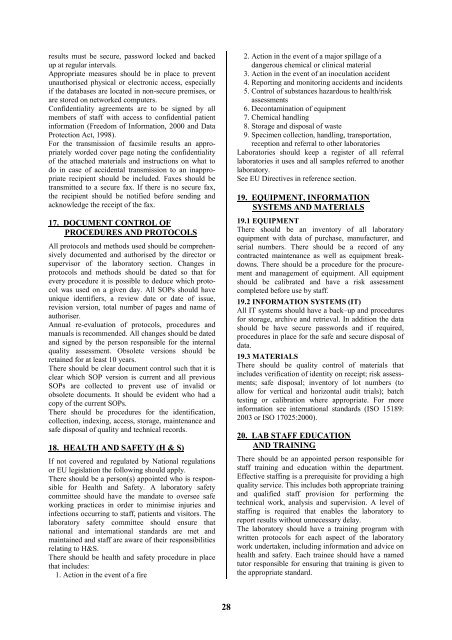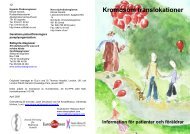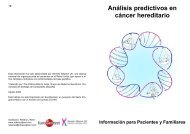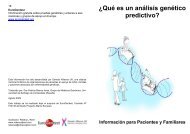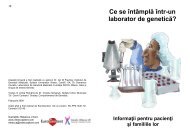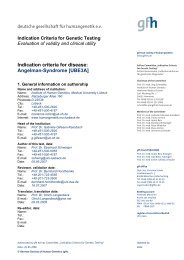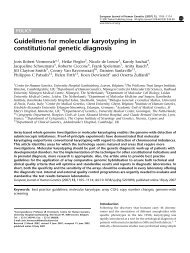Cytogenetic Guidelines and Quality Assurance - EuroGentest
Cytogenetic Guidelines and Quality Assurance - EuroGentest
Cytogenetic Guidelines and Quality Assurance - EuroGentest
Create successful ePaper yourself
Turn your PDF publications into a flip-book with our unique Google optimized e-Paper software.
esults must be secure, password locked <strong>and</strong> backed<br />
up at regular intervals.<br />
Appropriate measures should be in place to prevent<br />
unauthorised physical or electronic access, especially<br />
if the databases are located in non-secure premises, or<br />
are stored on networked computers.<br />
Confidentiality agreements are to be signed by all<br />
members of staff with access to confidential patient<br />
information (Freedom of Information, 2000 <strong>and</strong> Data<br />
Protection Act, 1998).<br />
For the transmission of facsimile results an appropriately<br />
worded cover page noting the confidentiality<br />
of the attached materials <strong>and</strong> instructions on what to<br />
do in case of accidental transmission to an inappropriate<br />
recipient should be included. Faxes should be<br />
transmitted to a secure fax. If there is no secure fax,<br />
the recipient should be notified before sending <strong>and</strong><br />
acknowledge the receipt of the fax.<br />
17. DOCUMENT CONTROL OF<br />
PROCEDURES AND PROTOCOLS<br />
All protocols <strong>and</strong> methods used should be comprehensively<br />
documented <strong>and</strong> authorised by the director or<br />
supervisor of the laboratory section. Changes in<br />
protocols <strong>and</strong> methods should be dated so that for<br />
every procedure it is possible to deduce which protocol<br />
was used on a given day. All SOPs should have<br />
unique identifiers, a review date or date of issue,<br />
revision version, total number of pages <strong>and</strong> name of<br />
authoriser.<br />
Annual re-evaluation of protocols, procedures <strong>and</strong><br />
manuals is recommended. All changes should be dated<br />
<strong>and</strong> signed by the person responsible for the internal<br />
quality assessment. Obsolete versions should be<br />
retained for at least 10 years.<br />
There should be clear document control such that it is<br />
clear which SOP version is current <strong>and</strong> all previous<br />
SOPs are collected to prevent use of invalid or<br />
obsolete documents. It should be evident who had a<br />
copy of the current SOPs.<br />
There should be procedures for the identification,<br />
collection, indexing, access, storage, maintenance <strong>and</strong><br />
safe disposal of quality <strong>and</strong> technical records.<br />
18. HEALTH AND SAFETY (H & S)<br />
If not covered <strong>and</strong> regulated by National regulations<br />
or EU legislation the following should apply.<br />
There should be a person(s) appointed who is responsible<br />
for Health <strong>and</strong> Safety. A laboratory safety<br />
committee should have the m<strong>and</strong>ate to oversee safe<br />
working practices in order to minimise injuries <strong>and</strong><br />
infections occurring to staff, patients <strong>and</strong> visitors. The<br />
laboratory safety committee should ensure that<br />
national <strong>and</strong> international st<strong>and</strong>ards are met <strong>and</strong><br />
maintained <strong>and</strong> staff are aware of their responsibilities<br />
relating to H&S.<br />
There should be health <strong>and</strong> safety procedure in place<br />
that includes:<br />
1. Action in the event of a fire<br />
28<br />
2. Action in the event of a major spillage of a<br />
dangerous chemical or clinical material<br />
3. Action in the event of an inoculation accident<br />
4. Reporting <strong>and</strong> monitoring accidents <strong>and</strong> incidents<br />
5. Control of substances hazardous to health/risk<br />
assessments<br />
6. Decontamination of equipment<br />
7. Chemical h<strong>and</strong>ling<br />
8. Storage <strong>and</strong> disposal of waste<br />
9. Specimen collection, h<strong>and</strong>ling, transportation,<br />
reception <strong>and</strong> referral to other laboratories<br />
Laboratories should keep a register of all referral<br />
laboratories it uses <strong>and</strong> all samples referred to another<br />
laboratory.<br />
See EU Directives in reference section.<br />
19. EQUIPMENT, INFORMATION<br />
SYSTEMS AND MATERIALS<br />
19.1 EQUIPMENT<br />
There should be an inventory of all laboratory<br />
equipment with data of purchase, manufacturer, <strong>and</strong><br />
serial numbers. There should be a record of any<br />
contracted maintenance as well as equipment breakdowns.<br />
There should be a procedure for the procurement<br />
<strong>and</strong> management of equipment. All equipment<br />
should be calibrated <strong>and</strong> have a risk assessment<br />
completed before use by staff.<br />
19.2 INFORMATION SYSTEMS (IT)<br />
All IT systems should have a back–up <strong>and</strong> procedures<br />
for storage, archive <strong>and</strong> retrieval. In addition the data<br />
should be have secure passwords <strong>and</strong> if required,<br />
procedures in place for the safe <strong>and</strong> secure disposal of<br />
data.<br />
19.3 MATERIALS<br />
There should be quality control of materials that<br />
includes verification of identity on receipt; risk assessments;<br />
safe disposal; inventory of lot numbers (to<br />
allow for vertical <strong>and</strong> horizontal audit trials); batch<br />
testing or calibration where appropriate. For more<br />
information see international st<strong>and</strong>ards (ISO 15189:<br />
2003 or ISO 17025:2000).<br />
20. LAB STAFF EDUCATION<br />
AND TRAINING<br />
There should be an appointed person responsible for<br />
staff training <strong>and</strong> education within the department.<br />
Effective staffing is a prerequisite for providing a high<br />
quality service. This includes both appropriate training<br />
<strong>and</strong> qualified staff provision for performing the<br />
technical work, analysis <strong>and</strong> supervision. A level of<br />
staffing is required that enables the laboratory to<br />
report results without unnecessary delay.<br />
The laboratory should have a training program with<br />
written protocols for each aspect of the laboratory<br />
work undertaken, including information <strong>and</strong> advice on<br />
health <strong>and</strong> safety. Each trainee should have a named<br />
tutor responsible for ensuring that training is given to<br />
the appropriate st<strong>and</strong>ard.


